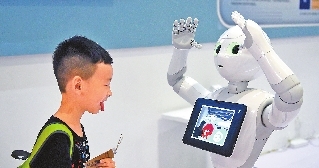
“PETS are lonely when their masters are away from home, and we are here to reduce their loneliness,” said Yang Xu, a product manager of AntHouse. “It also helps to ease people’s concerns when their pets are left home alone.” Yang attended the 2018 World Robot Conference, a robotics gala held in Beijing from Wednesday to Sunday comprising of more than 160 domestic and international corporations. Xiaoyi, a pet companion robot from AntHouse, a Shenzhen-based robotics company, functioned as an automated entertainment-partner and a dog-feeder. It also functions in “remote control mode,” allowing people to interact with their pets via live feeds displayed on their complementary app. Robots are not a new topic in China. As the world’s largest industrial robot-market, China hit a sales record of 141,000 units in 2017. China has witnessed the generation of a host of robotics applications in art and other realms. A calligraphy-writing robot in 2016 and a bionic jellyfish robot in 2017 mesmerized attendees at previous world robot conferences. This year, above and beyond conventional industrial and service robots, companion robots enthralled all who were present. The integration of routine services and emotional care highlighted the biggest difference between companion robots and others. P-Care, a senior-care robot from Zhongrui Funing Robotics Co., is capable of examining patients’ health, delivering food and medicine, as well as assisting seniors to move about. It even helps them to shower. “Emotional consolation and individualized communication are keys to companion robots,” Wang Daning, vice president of the company, told Xinhua. “Through facial detection, P-Care can distinguish each elderly and directly call out his or her name. It can also differentiate the elders’ moods and provide the appropriate responses, including singing a song to entertain or connecting elders with their relatives to relieve their loneliness.” Xiaowu on the other hand, is a children’s companion robot from Hanwuji Intelligence, and communicates via age-based interactive content. Xiaowu can sing and dance with children, deliver lectures as well as tell bed time stories. It can also automatically take photos and videos through voice-activation or via app-instruction. Though these companion robots attracted many visitors at the exhibitions, the producer said that they still face many market challenges. “The fact is, we (the robotics companies) are all striving to get market recognition,” an employee at Hanwuji Intelligence told Xinhua. “Over the last two years, at least 70 percent of the companies that focused on companion robots went bankrupt.” “In order to truly relieve people’s need of companionship, robots need more than ‘a heart and mind’ to hear and understand, but also a real sense of touch and warmth. As for the companion robots on the market, I must say, the technology gap between the ideal and reality is still huge.” said Liu, a conference visitor who currently studies in a psychology masters’ program in the Chinese Academy of Sciences. (Xinhua) | 
